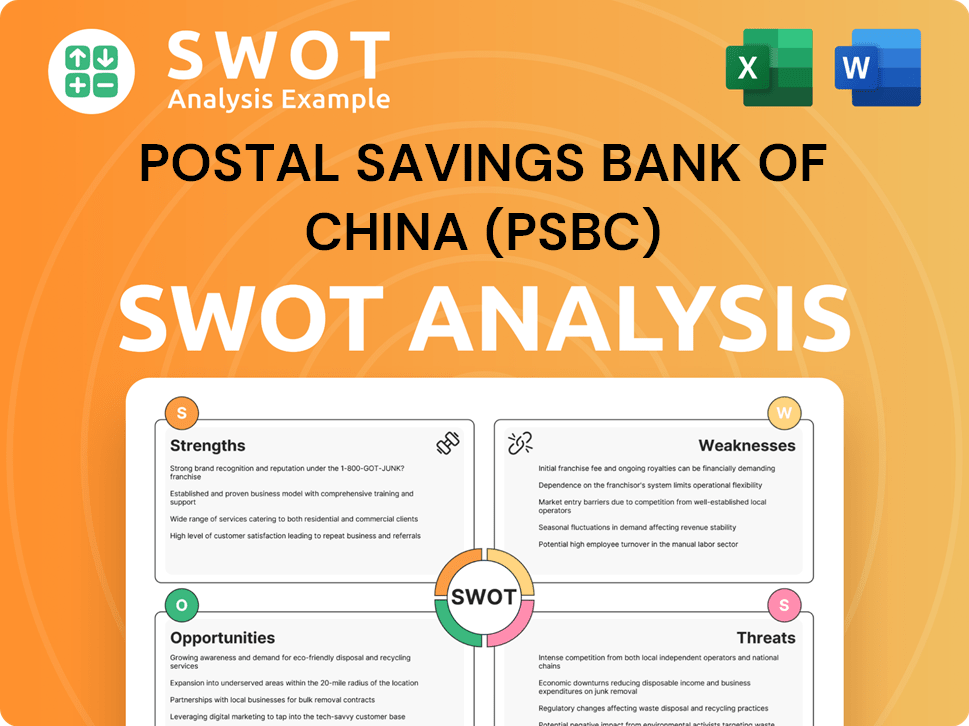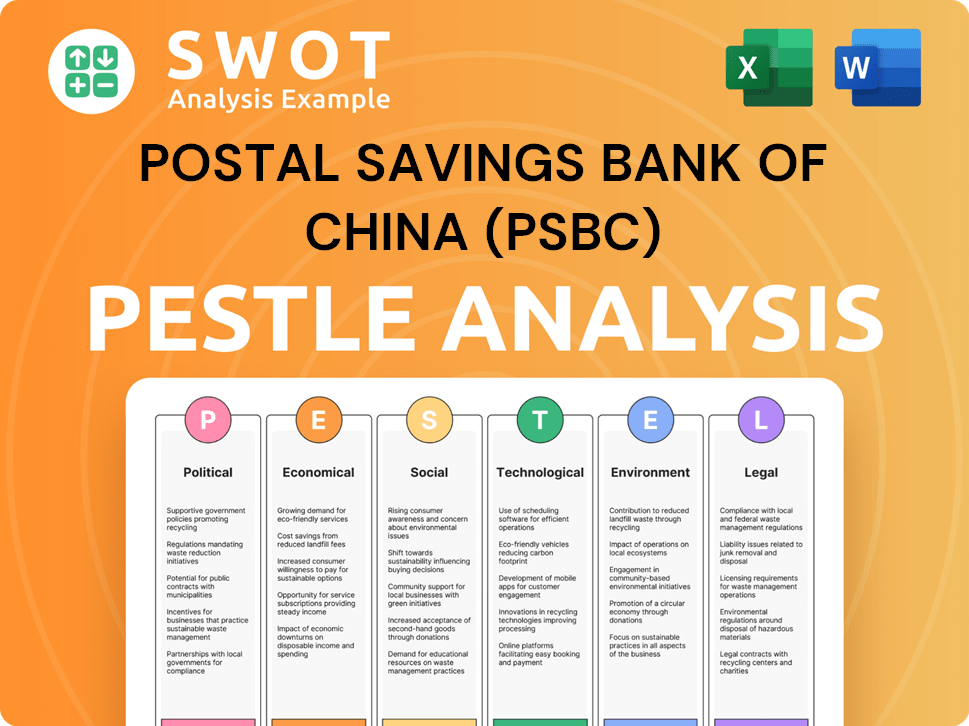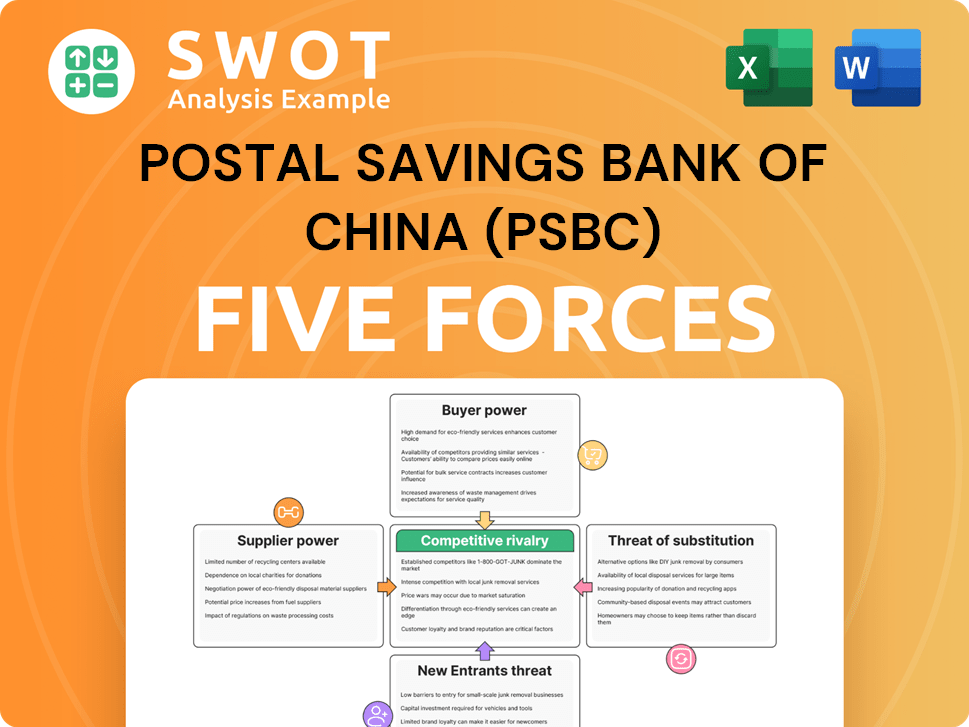Postal Savings Bank Of China (PSBC) Bundle
Can PSBC Conquer the Future of Banking?
Postal Savings Bank of China (PSBC) is charting a course for significant growth, focusing on digital innovation and expanding its reach, especially in rural markets. This strategic shift is critical in China's dynamic banking industry, where fintech and evolving customer demands are reshaping the landscape. Established in 2007, PSBC leverages its unique heritage and extensive network to provide universal financial services.

With total assets exceeding 16 trillion yuan by the end of 2023, PSBC's market position is undeniable. To understand its trajectory, consider a deep dive into the Postal Savings Bank Of China (PSBC) SWOT Analysis. This analysis will unravel PSBC's strategic moves in the Chinese Economy, including its Growth Strategy, and its impact on Financial Services.
How Is Postal Savings Bank Of China (PSBC) Expanding Its Reach?
The expansion initiatives of Postal Savings Bank of China (PSBC) are primarily focused on strengthening its presence in rural regions and broadening its digital reach to capture a wider customer base, encompassing both urban and rural demographics. PSBC continues to leverage its extensive network of branches and outlets, many of which are situated in underserved areas, to offer a comprehensive array of financial products and services. A key strategic move involves enhancing its 'Sannong' (agriculture, rural areas, and farmers) financial services, with a focus on increasing loan disbursements to agricultural businesses and rural households. This approach aims to contribute to financial inclusion and support the growth of the Chinese economy.
PSBC's strategy also includes significant investments in digital transformation to meet the increasing demand for convenient and accessible financial services. This involves the launch of new online banking platforms, mobile applications, and digital payment solutions. The bank aims to attract new customers and retain existing ones by providing a seamless omni-channel experience. Furthermore, PSBC is exploring partnerships with fintech companies and e-commerce platforms to expand its service offerings and reach new customer segments. These initiatives are designed to enhance operational efficiency and improve customer satisfaction.
While the bank's international expansion plans are less prominent, the domestic strategy centers on optimizing its branch network and enhancing its digital infrastructure to maximize its reach and efficiency. This includes strategic investments in technology and infrastructure to support its digital transformation efforts. By focusing on these key areas, PSBC aims to maintain its competitive edge and drive sustainable growth within the dynamic landscape of the Competitors Landscape of Postal Savings Bank Of China (PSBC).
PSBC is heavily invested in expanding its footprint in rural areas. This involves increasing the number of branches and service points in these regions. The bank's strategy includes offering tailored financial products and services to meet the specific needs of rural customers.
PSBC is actively pursuing digital transformation to enhance customer experience and operational efficiency. This includes investments in online banking platforms, mobile applications, and digital payment solutions. The bank aims to provide a seamless and convenient banking experience across all channels.
PSBC is committed to enhancing its 'Sannong' financial services, focusing on agriculture, rural areas, and farmers. This involves increasing loan disbursements to agricultural businesses and rural households. The bank's efforts support financial inclusion and contribute to the growth of the rural economy.
PSBC is exploring partnerships with fintech companies and e-commerce platforms to expand its service offerings. These collaborations aim to reach new customer segments and enhance the bank's digital capabilities. Strategic alliances are key to driving innovation and growth.
PSBC's growth strategy is driven by several key factors, including its extensive branch network, digital transformation initiatives, and focus on 'Sannong' services. These factors contribute to its ability to reach a broad customer base and provide a wide range of financial products and services. The bank's commitment to innovation and customer satisfaction is also critical to its success.
- Extensive Branch Network: Leveraging its widespread physical presence, especially in rural areas.
- Digital Innovation: Implementing new online platforms and mobile applications.
- 'Sannong' Focus: Increasing financial support for agriculture and rural development.
- Strategic Partnerships: Collaborating with fintech and e-commerce companies.
Postal Savings Bank Of China (PSBC) SWOT Analysis
- Complete SWOT Breakdown
- Fully Customizable
- Editable in Excel & Word
- Professional Formatting
- Investor-Ready Format

How Does Postal Savings Bank Of China (PSBC) Invest in Innovation?
The PSBC is significantly investing in technology and innovation to fuel its sustained growth within the Financial Services sector. This strategic move is a key component of its broader Growth Strategy, aimed at enhancing its market position and operational efficiency. The bank's focus on digital transformation underscores its commitment to adapting to the evolving demands of the Banking Industry and the broader Chinese Economy.
The bank is actively deploying advanced technologies to improve customer experience and streamline operations. This includes using big data and AI to personalize financial products and refine credit assessment models, especially for its rural customer base. This approach reflects PSBC's dedication to leveraging technology to achieve its strategic objectives.
The bank is also developing new digital platforms and services, including smart banking outlets, mobile payment solutions, and online wealth management products. These initiatives aim to create a more integrated and intelligent financial service ecosystem. The bank's commitment to innovation is further demonstrated by its efforts in promoting green finance and sustainable development through technological applications.
The bank is making substantial R&D investments in areas such as big data, artificial intelligence (AI), cloud computing, and blockchain. These investments are crucial for enhancing customer experience and operational efficiency.
AI and big data analytics are used to develop personalized financial products and improve credit assessment models. This is particularly important for its rural customer base, enhancing financial inclusion.
The bank is focused on developing new digital platforms and services, including smart banking outlets, mobile payment solutions, and online wealth management products. This aims to create a more integrated ecosystem.
Efforts are being made to promote green finance and sustainable development through technological applications. This aligns with the bank's commitment to environmental sustainability.
The bank is using technology to enhance customer experience, making financial services more accessible and user-friendly. This is a key driver of customer satisfaction and loyalty.
Technology is deployed to optimize operational efficiency, reducing costs and improving service delivery. This helps the bank remain competitive in the market.
The bank's technological advancements are aimed at improving various aspects of its operations and services. These initiatives are crucial for its long-term growth and market competitiveness.
- AI-Driven Credit Assessment: Using AI to improve the accuracy and efficiency of credit risk assessment, particularly for rural customers.
- Digital Platforms: Developing and enhancing digital platforms for mobile banking, online wealth management, and smart banking outlets.
- Green Finance Technology: Implementing technological solutions to support green finance initiatives and promote sustainable development.
- Big Data Analytics: Leveraging big data to personalize financial products and improve customer service.
- Cloud Computing: Utilizing cloud computing to enhance operational efficiency and scalability of services.
Postal Savings Bank Of China (PSBC) PESTLE Analysis
- Covers All 6 PESTLE Categories
- No Research Needed – Save Hours of Work
- Built by Experts, Trusted by Consultants
- Instant Download, Ready to Use
- 100% Editable, Fully Customizable

What Is Postal Savings Bank Of China (PSBC)’s Growth Forecast?
The financial outlook for Postal Savings Bank of China (PSBC) remains positive, underpinned by its robust asset growth and strategic initiatives. The bank's performance in recent years reflects a strong position within the Banking Industry and the broader Chinese Economy. PSBC's ability to maintain a healthy balance sheet and expand its customer base is central to its growth strategy.
PSBC's focus on digital transformation and diversification of revenue streams is expected to further strengthen its financial position. This includes increasing revenue from non-interest income sources, such as wealth management and investment banking services. The bank's commitment to prudent risk management also supports its financial stability and long-term growth prospects. For a deeper understanding of the bank's origins, you can read a Brief History of Postal Savings Bank Of China (PSBC).
As of September 30, 2023, PSBC's total assets reached 16.03 trillion yuan, showcasing significant growth. The bank's net profit for the first three quarters of 2023 was 86.20 billion yuan, a year-on-year increase of 2.25%. These figures highlight PSBC's strong financial performance and its ability to generate profits.
PSBC's asset quality remains strong, with a non-performing loan (NPL) ratio of 0.81% at the end of 2023. This demonstrates the bank's effective risk management practices and its ability to maintain a healthy loan portfolio. Maintaining high asset quality is crucial for sustainable growth.
The bank's capital adequacy ratio stood at 13.91% as of December 31, 2023, providing a substantial capital buffer. This strong capital position allows PSBC to support future growth, absorb potential shocks, and invest in new opportunities. This is a key aspect of PSBC's Growth Strategy.
PSBC is actively increasing its revenue from non-interest income sources. This includes wealth management and investment banking services. This diversification strategy helps to reduce reliance on traditional interest income and enhances overall profitability. This is part of PSBC's Financial Services expansion.
The bank's strategic focus on digital transformation is a key driver of its future growth. This includes investments in technology and digital platforms to enhance customer experience and operational efficiency. These initiatives are crucial for adapting to fintech and improving PSBC market share analysis.
Analyst forecasts generally project continued steady growth for PSBC, supported by its extensive retail network and increasing digital capabilities. PSBC's expansion plans and commitment to sustainable development are key factors. The bank's PSBC future investment opportunities are also promising.
- Continued growth in customer base.
- Further development of digital banking services.
- Expansion of wealth management offerings.
- Focus on PSBC digital transformation initiatives.
Postal Savings Bank Of China (PSBC) Business Model Canvas
- Complete 9-Block Business Model Canvas
- Effortlessly Communicate Your Business Strategy
- Investor-Ready BMC Format
- 100% Editable and Customizable
- Clear and Structured Layout

What Risks Could Slow Postal Savings Bank Of China (PSBC)’s Growth?
While the outlook for Postal Savings Bank of China (PSBC) appears promising, several potential risks and obstacles could influence its growth trajectory. Intense competition within the financial services sector and the rapid pace of technological advancements pose significant challenges. Adapting to regulatory changes and managing internal resource constraints are also critical for PSBC's continued success.
The banking industry in China is highly competitive, with both state-owned and private banks vying for market share. Fintech companies are also emerging as significant players, intensifying the pressure on traditional banks like PSBC to innovate and enhance their services. Effective risk management, particularly in areas like credit and operational risks, is crucial for navigating these challenges.
The success of PSBC's growth strategy hinges on its ability to address these potential pitfalls proactively. The bank's strategic initiatives and its ability to adapt to the evolving financial landscape will be key determinants of its future performance and its ability to capitalize on opportunities within the Chinese economy.
PSBC faces stiff competition from other state-owned banks, joint-stock banks, and fintech companies. These competitors are investing heavily in digital transformation, which requires PSBC to continuously innovate. The ability to maintain a competitive edge is crucial for PSBC's growth strategy.
Changes in China's financial regulations, especially those related to data privacy and consumer protection, could impact PSBC's operations. Compliance with these regulations is essential for maintaining profitability and ensuring financial stability. Adapting to these changes requires a proactive approach.
While less direct, supply chain disruptions could indirectly affect PSBC's customers, particularly in the agricultural sector. This could impact loan repayments and overall economic stability in rural areas. Monitoring and mitigating these risks are essential for financial health.
Rapid technological advancements present both opportunities and risks for PSBC. The bank must keep pace with these changes to effectively integrate new technologies. Failure to do so could hinder its competitiveness in the financial services sector.
A shortage of skilled talent in areas like AI and data analytics could hinder PSBC's innovation efforts. Addressing these internal resource gaps is crucial for achieving its growth objectives. Investing in talent development is a key strategy.
A slowdown in the Chinese economy could impact loan performance and overall profitability. PSBC must be prepared for potential economic fluctuations. Diversifying its loan portfolio and maintaining a robust risk management framework are important.
PSBC addresses these risks through a comprehensive risk management framework. This includes robust credit risk management, operational risk management, and compliance programs. The bank's focus on risk mitigation helps to safeguard its financial health. The bank's risk management strategies are constantly evolving to adapt to the changing financial landscape.
PSBC engages in scenario planning to assess and prepare for various potential challenges. This proactive approach allows the bank to anticipate and respond effectively to market changes. Scenario planning helps to improve its resilience. This helps PSBC to be prepared for unexpected events.
Postal Savings Bank Of China (PSBC) Porter's Five Forces Analysis
- Covers All 5 Competitive Forces in Detail
- Structured for Consultants, Students, and Founders
- 100% Editable in Microsoft Word & Excel
- Instant Digital Download – Use Immediately
- Compatible with Mac & PC – Fully Unlocked

Related Blogs
- What are Mission Vision & Core Values of Postal Savings Bank Of China (PSBC) Company?
- What is Competitive Landscape of Postal Savings Bank Of China (PSBC) Company?
- How Does Postal Savings Bank Of China (PSBC) Company Work?
- What is Sales and Marketing Strategy of Postal Savings Bank Of China (PSBC) Company?
- What is Brief History of Postal Savings Bank Of China (PSBC) Company?
- Who Owns Postal Savings Bank Of China (PSBC) Company?
- What is Customer Demographics and Target Market of Postal Savings Bank Of China (PSBC) Company?
Disclaimer
All information, articles, and product details provided on this website are for general informational and educational purposes only. We do not claim any ownership over, nor do we intend to infringe upon, any trademarks, copyrights, logos, brand names, or other intellectual property mentioned or depicted on this site. Such intellectual property remains the property of its respective owners, and any references here are made solely for identification or informational purposes, without implying any affiliation, endorsement, or partnership.
We make no representations or warranties, express or implied, regarding the accuracy, completeness, or suitability of any content or products presented. Nothing on this website should be construed as legal, tax, investment, financial, medical, or other professional advice. In addition, no part of this site—including articles or product references—constitutes a solicitation, recommendation, endorsement, advertisement, or offer to buy or sell any securities, franchises, or other financial instruments, particularly in jurisdictions where such activity would be unlawful.
All content is of a general nature and may not address the specific circumstances of any individual or entity. It is not a substitute for professional advice or services. Any actions you take based on the information provided here are strictly at your own risk. You accept full responsibility for any decisions or outcomes arising from your use of this website and agree to release us from any liability in connection with your use of, or reliance upon, the content or products found herein.